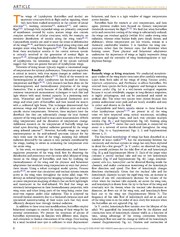File:S41467-020-14408-8.pdf
From Wikimedia Commons, the free media repository
Jump to navigation
Jump to search

Size of this JPG preview of this PDF file: 456 × 600 pixels. Other resolutions: 182 × 240 pixels | 365 × 480 pixels | 584 × 768 pixels | 1,239 × 1,629 pixels.
Original file (1,239 × 1,629 pixels, file size: 7.32 MB, MIME type: application/pdf, 14 pages)
File information
Structured data
Captions
Captions
Physical and behavioral adaptations to prevent overheating of the living wings of butterflies
Summary
[edit]| DescriptionS41467-020-14408-8.pdf |
English: The wings of Lepidoptera contain a matrix of living cells whose function requires appropriate temperatures. However, given their small thermal capacity, wings can overheat rapidly in the sun. Here we analyze butterfly wings across a wide range of simulated environmental conditions, and find that regions containing living cells are maintained at cooler temperatures. Diverse scale nanostructures and non-uniform cuticle thicknesses create a heterogeneous distribution of radiative cooling that selectively reduces the temperature of structures such as wing veins and androconial organs. These tissues are supplied by circulatory, neural and tracheal systems throughout the adult lifetime, indicating that the insect wing is a dynamic, living structure. Behavioral assays show that butterflies use wings to sense visible and infrared radiation, responding with specialized behaviors to prevent overheating of their wings. Our work highlights the physiological importance of wing temperature and how it is exquisitely regulated by structural and behavioral adaptations. |
| Date | |
| Source |
https://www.nature.com/articles/s41467-020-14408-8 https://doi.org/10.1038/s41467-020-14408-8 |
| Author | Cheng-Chia Tsai, Richard A. Childers, Norman Nan Shi, Crystal Ren, Julianne N. Pelaez, Gary D. Bernard, Naomi E. Pierce & Nanfang Yu |
Licensing
[edit]This file is licensed under the Creative Commons Attribution 4.0 International license.
- You are free:
- to share – to copy, distribute and transmit the work
- to remix – to adapt the work
- Under the following conditions:
- attribution – You must give appropriate credit, provide a link to the license, and indicate if changes were made. You may do so in any reasonable manner, but not in any way that suggests the licensor endorses you or your use.
File history
Click on a date/time to view the file as it appeared at that time.
| Date/Time | Thumbnail | Dimensions | User | Comment | |
|---|---|---|---|---|---|
| current | 09:51, 3 February 2020 |  | 1,239 × 1,629, 14 pages (7.32 MB) | Pamputt (talk | contribs) | User created page with UploadWizard |
You cannot overwrite this file.
File usage on Commons
There are no pages that use this file.
Metadata
This file contains additional information such as Exif metadata which may have been added by the digital camera, scanner, or software program used to create or digitize it. If the file has been modified from its original state, some details such as the timestamp may not fully reflect those of the original file. The timestamp is only as accurate as the clock in the camera, and it may be completely wrong.
| Short title | Physical and behavioral adaptations to prevent overheating of the living wings of butterflies |
|---|---|
| Image title | Nature Communications, doi:10.1038/s41467-020-14408-8 |
| Author | Cheng-Chia Tsai |
| Software used | Springer |
| Conversion program | iText® 5.3.5 ©2000-2012 1T3XT BVBA (SPRINGER SBM; licensed version) |
| Encrypted | no |
| Page size | 595.276 x 782.362 pts |
| Version of PDF format | 1.4 |
Hidden categories:
